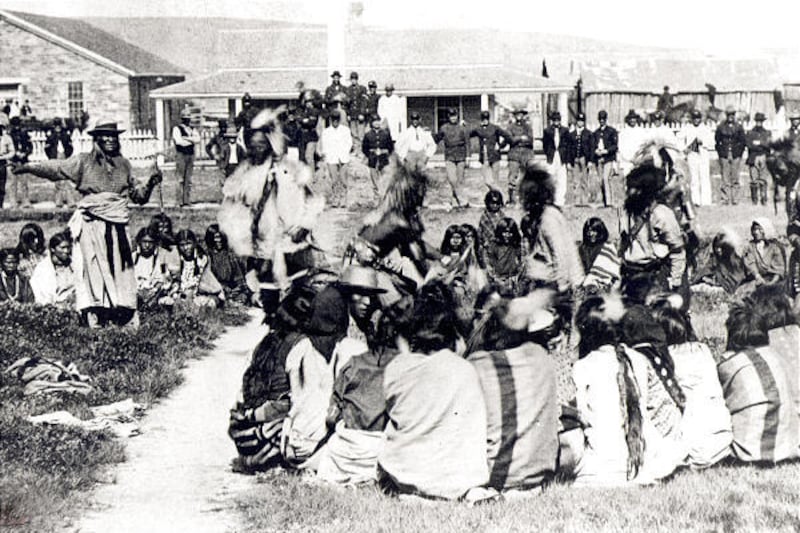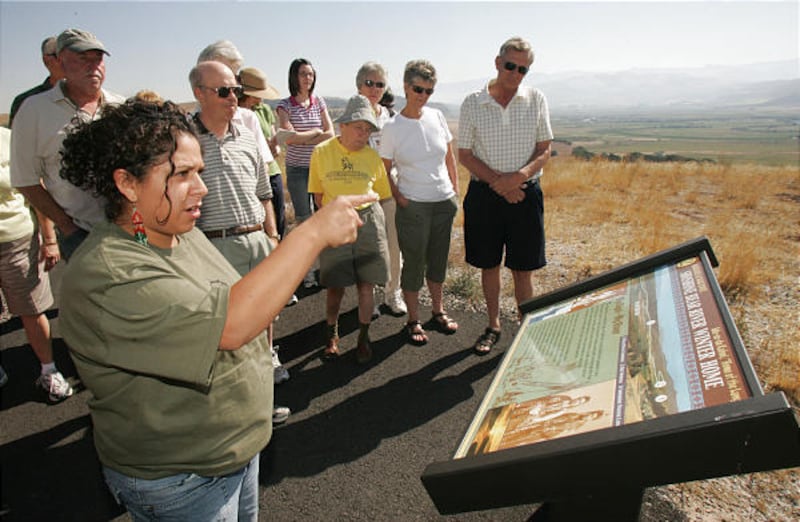Important dates in the history of the Northwestern Band of the Shoshone Nation since Euro-American contact:
1810: Approximate time fur traders move into Shoshone territory.
1856: Mormon settlers first come to Cache Valley, the heart of traditional Northwestern Shoshone lands.
1863: On Jan. 29, Col. Patrick Connor and about 200 U.S. Army volunteers from California attack a Shoshone winter village 12 miles northwest of Franklin (now in Idaho). Between 250-300 Shoshone men, women and children are slain. On July 30, the Treaty of Box Elder is signed, "re-establishing friendly and amicable relations" between the United States and Shoshones.
1875: Spring — more than 600 Shoshone Indians baptized into LDS Church.
1875: Summer — the first permanent home is established near Corinne, Utah. By late summer, non-LDS settlers of Corinne call on the U.S. Army to force the Shoshone to leave the area.
1876: Using the Homestead Act, Isaac Zundel, a local Mormon, helps many Shoshone acquire land near Elwood, Utah.
1880: The Shoshone move to the LDS Cooperative Farm, located near Portage, Utah, some 20 miles south of Malad, Idaho. They name the settlement Washakie after a well-respected Shoshone leader.
1882: The Washakie Day School is founded. Among the lessons taught is English. Most students only attend through the 3rd grade.
1924: Under the Indian Citizenship Act, all American Indians born in the United States receive citizenship.
1942: Many Shoshone leave Washakie to work World War II support jobs in Ogden or to join the military.
1960s: Many of the remaining homes in Washakie, which appear to be abandoned, are burned down in preparation for the 1972 sale of the LDS Church-owned farm.
1984: The LDS Church gives the Northwestern Shoshone 184 acres in the vicinity of Washakie to enable them to receive government aid and to have title to the cemetery where many of their family members are buried.
1987: The Northwestern Band of the Shoshone Nation is federally recognized as a distinct tribe.
1988: The Northwestern Band adopts a new constitution, reaffirming its rights and powers as a federally recognized tribe.
2003: 26 acres of land associated with the Bear River Massacre is purchased by the Northwestern Band and the Trust for Public Lands. The band also creates an Economic Development Corporation that allows them to pursue business opportunities.
SOURCE: American West Heritage Center
· · · · ·
Shoshone country
Some of the sites in northern Utah and southern Idaho associated with the Northwestern Band of the Shoshone Nation:
Living areas for early hunter-gatherers: Pre-Euro-American-contact areas frequented by tribe members include Mendon, Promontory Point, Kelton, Blue Creek, Grouse Creek, Salt Creek Marsh, Willard Bay and Cutler Dam.
Paradise: In southern Cache Country, this was one of the major gathering places for chokecherries.
Mantua: On U.S. 89 between Brigham City and Wellsville, this valley was occupied by Shoshone when pioneers arrived. A mound on the edge of the Mantua Reservoir is the burial place for He-weech, wife of Chief Sagwitch Timbimboo.
Crystal Hot Springs: On state Route U.S. 38 north of Honeyville, this was a gathering place for healing and also has a burial site.
Belmont Springs: South of Plymouth and now privately owned, this was another gathering place for healing.
Yost: In northern Box Elder County, a popular place for hunting and gathering pine nuts.
Bear River Massacre site: About 2.5 miles northwest of Preston on U.S. 91, there's a roadside marker and a second site with several explanatory panels on the hill overlooking the area.
Washakie Community: located between Plymouth and Portage in Box Elder County. Now on private land, the church, the bishop's house and the cemetery are about all that remain.
Elwood: The second farming community created with the help of the LDS Church. The meetinghouse there was eventually moved to Washakie.
Logan Temple: The hill the temple sits on was considered sacred ground to the Shoshone. After their conversion to the LDS Church and the building of the temple, the Shoshone still considered it sacred ground and many worked on the building, which was completed in 1884.
Museums and sites with Shoshone artifacts: American West Heritage Center, Wellsville; Paradise Museum; Utah State University Museum of Anthropology, Old Main Building, Logan; Brigham City Museum; Brigham City Court House; Tremonton Museum; Malad Idaho Museum; Franklin Idaho Museum.
Shoshone tribal office: 707 N. Main, Brigham City; 800-310-8241.
SOURCE: Northwestern Band of the Shoshone Nation
American West Heritage Center tour highlights Shoshone sites in Cache Valley



